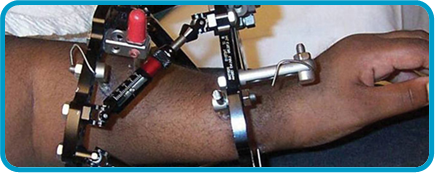El dispositivo TAYLOR SPATIAL FRAME se sujeta a la parte externa de la extremidad mediante clavos y alambres que penetran en la piel, atraviesan el hueso y salen del otro lado. Los lugares de colocación de los clavos son aquellos en donde los clavos y alambres atraviesan la piel.
Las infecciones en estos lugares son un problema común, pero pueden evitarse con el cuidado adecuado de los clavos. Tendrá la responsabilidad importante de asegurarse de que las áreas en las que se encuentran los clavos se limpien a diario. Debe prestar especial atención a que estas áreas estén limpias y libres de infecciones.
Cuidado de los lugares donde se encuentran los clavos
Su cirujano lo guiará con respecto a la limpieza y al cuidado adecuado de los lugares donde se encuentran los clavos. Deberá aprender a limpiar la sangre seca y las costras de estos lugares para evitar que la piel se adhiera a los clavos y para permitir la libre secreción del área. Masajear suavemente el área alrededor de los lugares donde se encuentran los clavos también puede ayudar a que la piel no se adhiera a los clavos. Sea cuidadoso al realizar estos masajes ya que mover la piel cerca de los clavos en exceso puede causar una infección. Si tiene dificultades para alcanzar o ver todos los lugares en los que se encuentran los clavos, pídale a un miembro de la familia o a un amigo que lo ayude, o use un espejo.
Asegúrese de seguir las recomendaciones de su cirujano para el cuidado adecuado de estas áreas y así evitar una infección.

Cómo ducharse con el fijador externo
Es posible que no se le permite ducharse durante aproximadamente cinco a siete días después de la colocación inicial del dispositivo TAYLOR SPATIAL FRAME™. Hasta que se le permita ducharse, es posible que su cirujano le indique limpiar los lugares donde se encuentran los clavos con bolitas de algodón y solución salina normal u otro antibiótico o limpiador tópico que él le recete. Durante los primeros días después de la colocación del fijador externo, es de esperar que se produzca una secreción amarilla clara o ligeramente sanguinolenta en los lugares donde se encuentran los clavos.
Mientras no haya heridas abiertas y su cirujano lo permita, podrá ducharse con el dispositivo TAYLOR SPATIAL FRAME. Puede considerar colocar un tapete de goma en la bañera, usar una silla para ducha o instalar una barandilla en la ducha para más seguridad. Se ha comprobado que, una vez que se le permita ducharse, limpiar los lugares donde se encuentran los clavos con agua y jabón líquido antibacteriano en la ducha es un método de cuidado de los clavos del fijador externo simple y eficaz. Permita que el agua y el jabón corran por la extremidad en la que tiene el fijador externo. No se frote. Enjuague y seque bien el fijador y la extremidad. Puede secarse con un secador de cabello configurado en aire tibio.
No se recomiendan las actividades que impliquen remojar el fijador externo en agua potencialmente contaminada. Esto significa no bañarse en agua natural de mar, río, etc. Sin embargo, su cirujano puede permitirle nadar en una piscina limpia con cloro una vez que se le retiren las suturas.
Infecciones en los lugares de colocación de los clavos
Debido a que tendrá clavos y alambres que le atraviesan la piel y el hueso, existe un riesgo de desarrollar infecciones en los lugares de colocación de los clavos. Con la limpieza, la protección y el cuidado adecuados de los lugares en los que se encuentran los clavos, es posible que nunca desarrolle una infección, lo cual es la meta. Llame a su cirujano si experimenta alguno de los siguientes síntomas:
- Enrojecimiento, calor e hinchazón en los lugares en los que se encuentran los clavos. Un poco de enrojecimiento es normal.
- Sensibilidad extrema en los lugares en los que se encuentran los clavos.
- Fiebre persistente de 100.5 grados Farenheit o más, tomada por vía oral.
- Secreción blanca, amarilla o verde espesa y turbia en los lugares en los que se encuentran los clavos. La secreción amarilla clara o ligeramente sanguinolenta es normal.
- Mal olor en los lugares en los que se encuentran los clavos.
Problemas en los nervios
Si experimenta dolor en un lugar sin clavos, puede ser un signo de un problema en los nervios. Esto se llama “dolor referido”. El siguiente signo es mayor o menor sensibilidad en el área del pie o la mano, según dónde esté ubicado el fijador externo. Puede experimentar estos síntomas durante la fase de corrección inicial de su tratamiento con el fijador TAYLOR SPATIAL FRAME. Informe estos síntomas a su cirujano lo antes posible. Estos pueden ser indicadores de irritación de los nervios.
◊ Marca comercial de Smith & Nephew